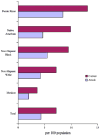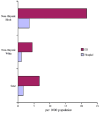Applying epidemiologic concepts of primary, secondary, and tertiary prevention to the elimination of racial disparities in asthma
- PMID: 16461121
- PMCID: PMC1904504
- DOI: 10.1016/j.jaci.2005.11.004
Applying epidemiologic concepts of primary, secondary, and tertiary prevention to the elimination of racial disparities in asthma
Abstract
Despite medical and scientific advances, racial and ethnic disparities persist in US asthma morbidity and mortality rates. Progress in the elimination of these disparities will involve disentangling the contribution of social constructs, such as race, socioeconomic status, and culture, from that of the physical environment and genetic susceptibility. One approach to reducing asthma disparities is through the traditional disease prevention stages of intervention. As such, primary prevention targets reductions in asthma incidence; secondary prevention is the mitigation of established disease and involves disease detection, management, and control; and tertiary prevention is the reduction of complications caused by severe disease. Once causative factors at each level of disease prevention are understood, this knowledge can be translated into clinical practice and public health policy.
Figures


References
Publication types
MeSH terms
Grants and funding
LinkOut - more resources
Full Text Sources
Medical
Research Materials

